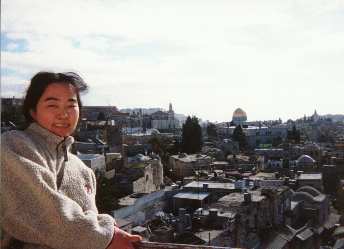A Land of Diversity
By Tim Young
From SIF SATELLITE 50, Summer 1998
 What
do you think of when someone mentions Israel? For many of us, it may
bring to mind war and violence. For decades, news reports from this
sliver of Mediterranean real estate have been dominated by images of
arguing and stubbornness, shooting and killing. A relative peace exists
today, but the ongoing tensions between Jews and Arabs are far from
resolved, and they may never be. Perhaps ironically, these tensions
exist primarily because of the importance of that region—especially
the city of Jerusalem—in three of the major religions of the world:
Judaism, Christianity, and Islam.
What
do you think of when someone mentions Israel? For many of us, it may
bring to mind war and violence. For decades, news reports from this
sliver of Mediterranean real estate have been dominated by images of
arguing and stubbornness, shooting and killing. A relative peace exists
today, but the ongoing tensions between Jews and Arabs are far from
resolved, and they may never be. Perhaps ironically, these tensions
exist primarily because of the importance of that region—especially
the city of Jerusalem—in three of the major religions of the world:
Judaism, Christianity, and Islam.
 |
|
Mioko Ozaki (L) and Akiko Kaneko at the Church of the Nativity,
Bethlehem.
|
This is, therefore, a region incredibly rich in history and diversity.
My student Mioko Ozaki, who traveled to Israel in December, 1997 with friend
Akiko Kaneko, says that Akiko chose Israel as a destination because “one of her friends visited
Israel, and he said Israel is wonderful because there is a diversity
of cultures.” What struck me as she described her photos to me
was how close together so many of the famous spots are: the Dome of
the Rock is right next to the Western Wall, and both are clearly visible
from the Mount of Olives, where Jesus was arrested. It’s landmark
after landmark of three of the world’s most influential religions,
packed together like commuters on a Tokyo train. “If you stay in
Jerusalem 4 or 5 days you can see many famous places,” says Mioko.
“Diversity” is an understatement; perhaps it’s no wonder
there have been tensions between the religions.
Arriving December 22, Mioko and Akiko stayed at the Gloria Hotel in
Jerusalem’s Old City. The old city is surrounded by a wall with
several gates; the Gloria is near the Jaffa Gate and King David’s
Tower. The wall was built by an Ottoman sultan in the mid-1500s. The
Old City and the areas to the north, east, and south make up East Jerusalem,
the section of the city claimed by the Palestinians but controlled by
Israel since 1967.
After a good night’s sleep, Mioko and Akiko went shopping in the
Old City. Mioko says, “there are many old shops and streets (in
the Old City). But there is much difference between the Old City and
the New City, because if you go out, well, that’s a normal European
city.” Inside the walls of the Old City, however, are brick streets
and clay buildings as they have existed for centuries.
 |
| Mioko with an excellent view of Jerusalem. |
On the first day they also went to the Holocaust Museum.
“There was an old man at the ticket office,” she recalls,
“and he talked a lot. He talked about the Holocaust. For a long
time he continued talking, talking, talking, and I wanted to see inside,
but he didn’t stop talking! For about half an hour he was talking,
and he said ‘we are thinking why the Holocaust happened’.”
Because he seemed to be old enough to remember that far back, Mioko
asked him where he was at the time of the Holocaust. “He said he
and his family were in New York, so they were safe. But he said maybe
God told the Israeli people that they can’t mix with other Europeans,”
she recalls. “Maybe God hoped that Israelis would make their own
country like Israel. So maybe God caused the Holocaust. I think that’s
his idea,” she goes on. “I’m not sure what kind of person
he is. But I asked ‘Are you a Jew?’ and he said ‘Yes,
I’m a Jew,’” she recalls, laughing. Not such a surprise,
she adds, “because he is at the Holocaust museum!”
Page
two >>
Travel
& Culture Home





 This page last updated
February 3, 2003
. E-mail Tim
This page last updated
February 3, 2003
. E-mail Tim